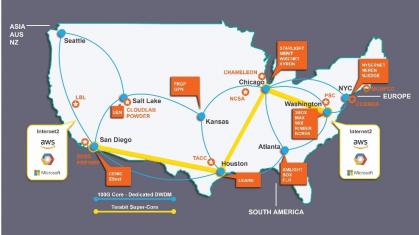Rutgers University Joins Researchers in $20 Million NSF-Funded Project to Develop the Internet of the Future
As part of its commitment to developing and providing advanced research computing and data cyberinfrastructure, Rutgers University’s Office of Advanced Research Computing (OARC) is joining the Renaissance Computing Institute of the University of North Carolina at Chapel Hill and other partners to create a platform for testing novel internet architectures that could enable a faster, more secure internet.

Funded by a $20 million National Science Foundation grant, the platform called FABRIC will help scientists reimagine and redesign the internet of the future based on today’s knowledge. The platform will give computer scientists a place to test networking and cybersecurity solutions and continue to extend the internet’s broad benefits for science and society.
At Rutgers University, Dr. Barr von Oehsen, associate vice president of OARC, a unit working with Rutgers’ Office of Research and Economic Development and Office of Information Technology, will serve as the lead researcher on the project. Working closely with Rutgers’ Wireless Information Network Laboratory (WINLAB), OARC will host FABRIC hardware, maintain its connectivity to the FABRIC network, and provide the necessary support and space for its operations. OARC and WINLAB will also maintain connections between the FABRIC hardware and locally hosted resources, including WINLAB’s ORBIT and COSMOS testbeds as well as the Rutgers University Science DMZ resources (CICNet), plus access to resources within the Eastern Regional Network.

“Cybersecurity is on everyone’s mind as data breaches become more frequent. The FABRIC platform offers a testbed where researchers can explore new and novel ways of providing network security, which will ultimately benefit a society that relies heavily on the internet for day-to-day operations,” explains von Oehsen. “Being part of the FABRIC project is a great opportunity for Rutgers to work in partnership with national leaders by offering resources, services, and expertise around testbeds designed to explore innovative ways for reimagining how data can be stored, computed and moved through shared infrastructure.”
When the internet was first established in the 1960s, no one envisioned the impact it would have on research, business, and the world. The current infrastructure has limitations, including security, that were not part of the original design for the computer networking architectures.
“These awards represent the first in NSF’s agency-wide effort to support the mid-range infrastructure that will be invaluable to strengthening the U.S. scientific research enterprise,” said Jim Ulvestad, National Science Foundation chief officer for research facilities. “The funded projects include an impressive collection of new design efforts and advanced instrumentation. These projects fill gaps and provide unique research capabilities for the U.S that will engage many early-career scientists and engineers in the pursuit of ground-breaking discoveries.”
The platform will consist of storage, computational and network hardware nodes connected by dedicated high-speed optical links. In addition to the interconnected, deeply-programmable core nodes deployed across the country, FABRIC nodes will include major national research facilities such as universities, national labs and supercomputing centers that generate and process enormous scientific data sets. Such flexible level of control over the network functions will allow experimenters to test their new architectures at scale. All major aspects of the FABRIC infrastructure will be programmable, so researchers can create new configurations or tailor the platform for specific research purposes, such as cybersecurity.
As the project’s lead institution, UNC-Chapel Hill will oversee the effort while also contributing to software development, supporting hardware deployment and assisting with outreach efforts. Other collaborating organizations include the University of Kentucky, the Department of Energy’s Energy Sciences Network, Clemson University and the Illinois Institute of Technology. Their work will focus on designing and deploying the platform’s hardware and developing new software as well as working with a wide variety of user communities—including those focused on security, distributed architectures, scientific applications, and data transfer protocols—to ensure FABRIC can serve their needs. Additionally, researchers from other universities will help test the platform and integrate their computing infrastructure and scientific instruments into FABRIC.
“We look forward to FABRIC enabling researchers throughout the nation to develop and test new networking technologies and capabilities,” said Erwin Gianchandani, acting assistant director for computer and information science and engineering at the National Science Foundation. “This project will lead to novel paradigms for next-generation networks and services, giving rise to future applications advancing science and the economy.”
The project’s construction phase is expected to take four years. The first year will be dedicated to software development and finalizing technical designs and prototyping. Subsequent years will focus on rolling out the platform’s hardware in participating sites across the nation and connecting it to major national computing facilities.


